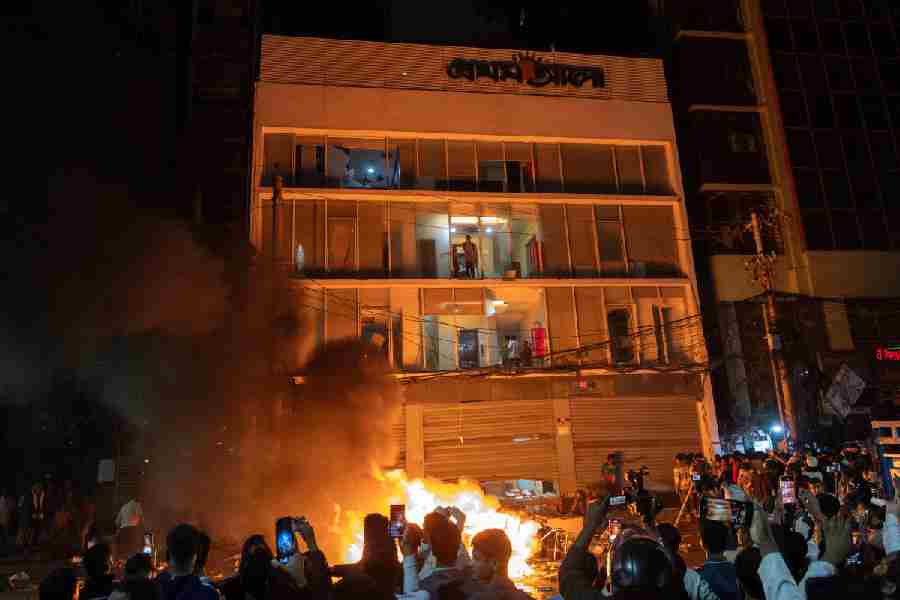.jpg)
The era of vendettas and violence, I was assured, has long vanished from the inland villages of Sardinia. My informant was our vivacious tour guide who was driving us around sharp hairpin bends up a hilly road to Orgosolo, a remote shepherds’ village on the sunny Mediterranean island. But my imagination and sense of adventure had been instantly stoked.
It was English novelist D.H. Lawrence who once described Sardinia and its ruggedly individualistic people as “belonging to nowhere, never having belonged to anywhere”. Sardinia’s one of Italy’s five autonomous regions, but it is famous for possessing a strong identity of its own. This was a constant strain in my conversations with Enza Tucconi who was my tour guide-cum-politician. Along with her cousin Giampaola, she pottered around the island with us in her trusty old car.
.jpg)
Pic : ARUNDHATI BASU
The holiday hit an adventurous note straightaway as Enza transported us from the small airport at Alghero into bandit country, driving along winding roads above stretches of virgin forests. Occasionally, we spotted the nuraghe, megalithic stone towers which are remnants of a bronze-age civilisation on the island. My eyes were riveted, however, by the limestone massifs of the Supramonte and the snow-capped peaks of the Gennargentu on the horizon.
The central person in Enza’s story was Orgosolo’s most famous resident, Graziano Mesina. A locally loved Robin Hood type of bandit, Mesina decided to give up banditry and turned — of all things — to being a tour guide. When I announced that I wanted to meet the unusual tour guide, Enza quickly stepped in to put an end to my indiscretion. “The people of Orgosolo eye newcomers warily. They are protected by the bandits and they in turn protect them from curious eyes,” she said. She warned that it was best that I did not broach the subject with the shepherds we were about to meet for lunch.
Orgosolo is tucked away in the wilds of the Barbagia region, Sardinia’s stunningly beautiful highland area. The name is derived from Barbaria, the ancient Roman word for ‘land of barbarians’ because they could not make successful inroads into it.
.jpg)
Apart from its fame as home to famous outlaws, Orgosolo is famous for its quirky, artistic murals. Narrow, hilly lanes took us past old, dilapidated houses painted with political and Cubist-style frescoes. In the ’70s, a Siennese schoolteacher and his students sparked off a trend of painting political murals in remembrance of the Italian Resistance and Liberation from Nazism and Fascism. The mural that imprinted itself on my brain was one that firmly stated: ‘Felice il popolo che non ha bisogna di eroi’ (‘Happy are the people who do not need heroes’). Even though it is said that the days of banditry and vendettas are over, a local poet was shot in public as recently as 2007 as part of a vendetta.
We headed straight to a large hall for a shepherd’s rustic-style lunch. The long-drawn lunch included — don’t underestimate the appetite of the Italians — creamy ricotta cheese, pink slices of ham, pungent sausage, porcheddu (suckling pig roasted upon a spit) and rosemary-flavoured sheep meat cooked with potatoes and pecorino cheese. This was paired with paper-thin bread called pane carasau and a thick roundel of pane, or bread, served up on rustic wooden boards.
The salty after-effect of all this had us reaching out for refills of the local red wine. By now our senses sufficiently doused in wine and grappa, we were treated to pretty looking desserts and the canto a tenore, a traditional shepherds’ performance. Four shepherds huddled together and the air soon rang with their folk songs.
.jpg)
Sardinia is an island of contrasts. It was evident the next day as we drove along its emerald coast, just a few hours from Orgosolo. On the island’s north-east coast lies the incredibly luxurious Costa Smeralda which was once just a wild region of rocky coves and sheep pastures.
That was until the Aga Khan decided to buy up the 35 mile-long stretch in the ’60s and turned it into a playground for himself and his A-Lister friends. He created incredible resorts and transformed the area into a playground for the world’s millionaires, tinsel town stars, Russian oligarchs, supermodels and playboys.
Costa Smeralda’s main ‘capital’ town of Porto Cervo, with its sun and sea, is one of Europe’s swishest addresses — and naturally a bank-breaking one. Pale pastel-hued villas rise above glittering blue waters and dozens of
super-large, luxury yachts are moored at the marina. This is the place where Princess Diana and Dodi Fayed were holidaying in 1997 just before their fatal accident. It’s also home to celebrities such as Formula One mogul Flavio Briatore, Italian prime minister Silvio Berlusconi and actor Denzel Washington.
.jpg)
It’s a short ferry ride to the beautiful Maddalena Archipelago — a collection of seven islands off Sardinia. We romped around La Maddalena, the main island, and then headed to the nearby Caprera island that was made famous by Italian revolutionary Giuseppe Garibaldi.
It was very easy to see why the Aga Khan was mesmerised by the pink-granite boulders, virgin beaches, unexplored coves and emerald-turquoise waters of this region.
On the crossroads to Costa Smeralda, I was fascinated by the idyllic little village of San Pantaleo, in the Gallura region of Sardinia, which is tucked into dramatic granite hills. Its remote location attracted artists, painters and sculptors from England, Germany, Scandinavia and France to set up home in the village alongside a group of local Gallurese craftsman in the ’70s, giving it a very bohemian feel.
It’s an entrancing place even though we got there on a miserably cold day, beset by an incessant drizzle, and a howling mistral (a strong, cold and northwesterly wind) which becomes pronounced during the change of
seasons (lucky us). Still, I loved the hills with their peaks shrouded in thick, smoky mist rising above that small
village of artists.

We also did the hikes. One was to Capo d’Orso (Cape Bear), a rock shaped by the mistral into the shape of a bear, near Palau, and the other in the old town of Castelsardo which is fortified and crowned by a castle, the Castello dei Doria.
Stopping by azure waters along which lie sleepy old towns taking their customary siestas, passing by fields of artichokes, we listened to romantic stories about Sardinian heroines like Eleanora d’Arborea and tucked into artisanal gelatos. And, all the while we soaked in the history of old Catalan towns like Alghero, stared into the ancient burial chambers in nuraghic complexes and contemplated the ephemeral nature of life.
The most special part of our holiday came at the end when we were invited home for a delectable meal by Enza’s mother Caterina. I have never feasted on more flavourful gnochettis, raviolis and lamb as I did that day and I was deeply touched by the warm-hearted generosity of the family. And, though I’ve always said that Bengalis have huge appetites, I’ve come to the conclusion that the Italians can give us all a run for our money when it comes to doing justice to all their gastronomical feats.
READY RECKONER
- How to get there: Air France, Qatar Airways, Alitalia and KLM fly from Delhi and Mumbai to Sardinia. They offer changes via Qatar, Rome, Paris, Amsterdam and Milan.
- Where to stay: Eurocamp (www.eurocamp.co.uk) in Isuledda in the Gulf of Arzachena offers deals for stays in pre-erected tents and mobile homes. Those with deeper pockets can book into the exclusive boutique hotel, Cala Di Volpe (www.caladivolpe.com), in Porto Cervo.
- How to get around: Carry your international driving licence because public transport is poor in Sardinia

.jpg)








